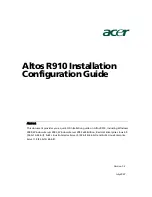
80
Option Cards
Note the following about PCI, ISA, and PnP option cards.
u
PCI: The system’s PCI expansion slots comply with the PCI 2.1 specification. Devices
that comply with the PCI 2.1 specification are fully plug-and-play. You do not have to
configure them after installation.
Some older PCI device drivers cannot share an interrupt, which is a violation of the PCI
2.1 specification. These should be treated as ISA devices. If you install a device that
uses such a driver (also called non-compliant PCI device), you must free an IRQ for the
device to work in the system.
u
ISA: ISA cards do not contain registers that define the resource information to the
system during startup. Some option cards include a configuration diskette that you can
use to reserve the system resources required for the card. Other option cards do not
include a diskette, but require that you manually program the BIOS with the
configuration information. If so, you must run AMIBIOS Setup to configure the BIOS
so the necessary system resources will be allocated to the card. Do this before installing
the card.
u
PnP: PnP cards are ISA cards that contain configuration registers like PCI cards.
During startup, the system BIOS automatically detects the installed card and assigns the
necessary system resources. Since a PnP card is ISA-based, you install it in the ISA slot.
Interrupt Requests
If you install an ISA device that requires an IRQ in the system, the BIOS automatically
configures the MIDI/Game port as a write-only device and makes IRQ 15 available. If you
install additional PCI devices that require additional IRQs, follow the steps for disabling an
unused system port below. Disabling an unused system port allows the IRQ for that port to
become free for other devices.
NOTE
In dual-processor systems, the system board has one available IRQ (IRQ 11).
To free IRQs for use by an ISA device or a PCI device that uses drivers that do not comply
with the PCI 2.l specification, you can use the system BIOS to disable unused system ports.
To disable an unused system port:
1. Restart the system.
2. When prompted to enter Setup, press
DEL
.
3. Select Setup; then select Peripheral Setup.
Содержание InterServe 80 SL
Страница 1: ...InterServe 80 System Setup December 1997 DHA025010 ...
Страница 4: ......
Страница 8: ...viii ...
Страница 14: ...xiv ...
Страница 22: ...8 ...
Страница 34: ...20 ...
Страница 78: ...64 ...
Страница 96: ...82 ...
Страница 106: ......













































